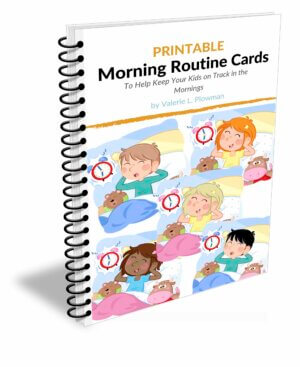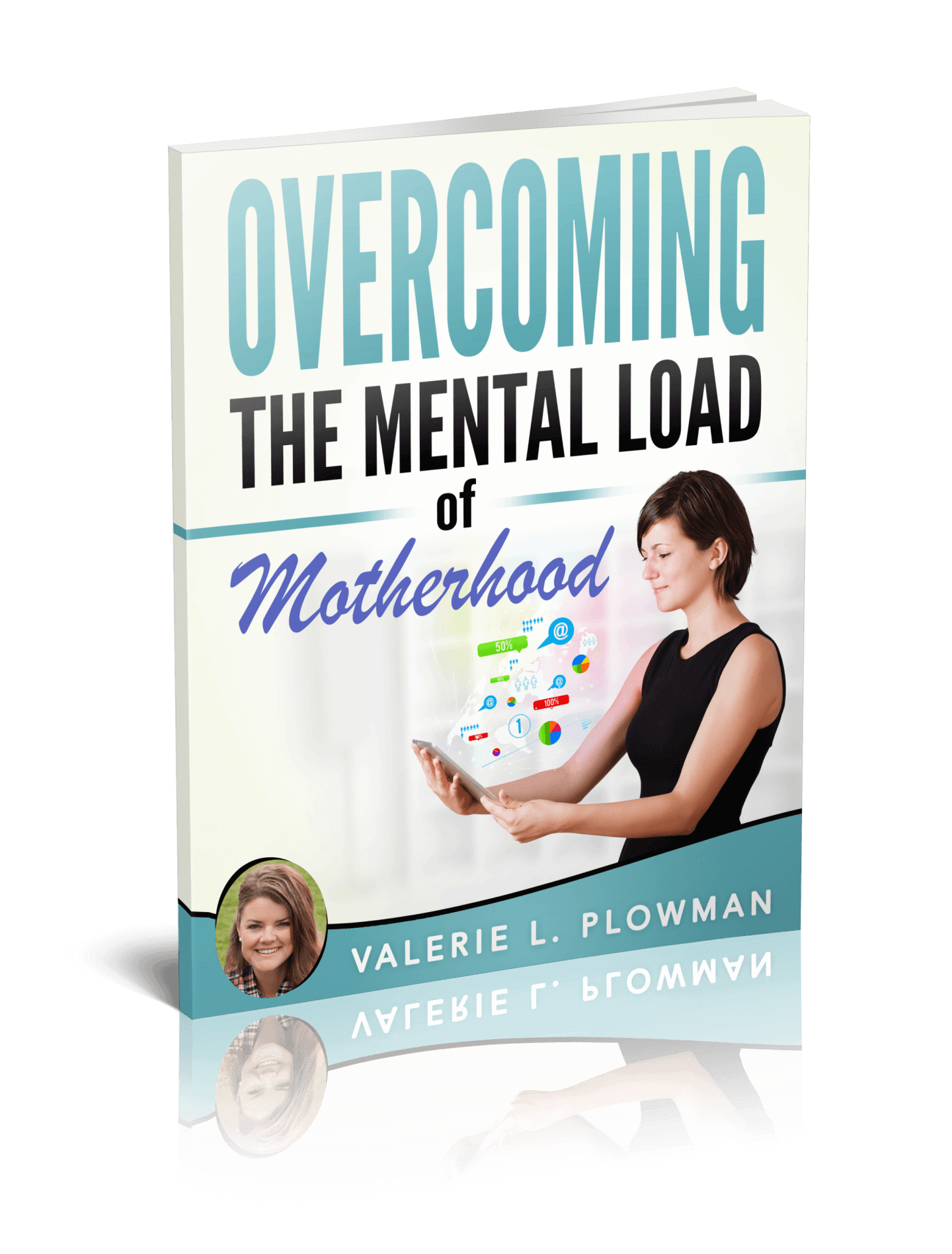How to determine how long your Babywise baby’s waketime length should be. How to know when to extend baby’s waketime length and get a free worksheet to figure it all out.

Parents often have questions about waketime length. How long should waketime be for my X month old? How do I extend it? WHEN do I extend it?
While a baby will continually extend wake time length throughout the first year of life, extending waketime length is not always the answer, and extending when you shouldn’t or extending too far can lead to continued or more sleep problems.
The question remains, how do I know it is time to extend baby wake time length?
I am going to give one of the most-despised answers to that.
It depends on the child.
It really does! At 5 months old, Brayden, my oldest, would stay awake for 2 hours. Conversely, Kaitlyn, my second, could not stay awake longer than 1 hour. McKenna, my third, varied from 1 hour to 2 hour waketime as a 5 month old. Brinley, my youngest, varied from 1 hour 15 minutes to 2 hours for her waketime lengths as a 5 month old.
Perfect wake time length for baby is super dependent on the indvidual baby. It is impacted by baby’s natural sleep needs (some are hight sleep needs and some are low sleep needs, while others are somewhere in between). It is impacted by your lifestyle. It is impacted by siblings. More stimulation in life often means a shorter waketime is needed.
So how long can/should your baby stay awake? This is one of those things you are going to have to determine for yourself. Here are some tools to help you out. Be sure to check out my free Wake Time Length Worksheet to figure out if you should extend wake time or not.
Post Contents
- Know How to Calculate Waketime Length
- Wake Time Length vs. Wake Window
- Why We Care About Baby’s Wake Windows
- Know When it is Time to Extend Wake Time Length
- Baby’s Disposition
- Baby’s Nap Length or Night Sleep
- Baby’s Sleep Cues
- Baby’s Time Falling Asleep
- Baby’s Falling Asleep Patterns
- Baby’s Feeding Times
- Baby’s Age
- Extending Wake Time Length
- General Guidelines to Extend Wake Windows
- Related Waketime Length Posts
- Reader Waketime Length Questions
Know How to Calculate Waketime Length
Many parents are unsure of how to calculate waketime. Waketime starts the minute baby wakes up and ends the minute baby goes down for a nap.
Waketime includes feeding time, even for a newborn. Yes, the time awake is so short, but it is what they need. Pretty soon baby will be staying up long hours and playing with you. It just gets more and more fun.
If you are still not totally sure about how to calculate wake time length, see the post How To Calculate Waketime Length. You will also want to know How To Calculate Waketime Length When Baby Wakes Early
Wake Time Length vs. Wake Window
A wake window is the same thing as wake time length. When you see these two different phrases used, they are used to communicate the same thing. They can be used interchangeably. I most often say waketime length, but wake time length and wake window all work.
Why We Care About Baby’s Wake Windows
If you are trying to establish solid sleep schedules, you must have baby’s wake windows down correctly.
An overtired baby will not sleep well. Neither will an undertired baby.
>>>Read: How to Tell if Baby is Overtired vs. Undertired
We care because we want good nap schedules. In order to get that, we need an appropriate wake window for our individual baby.
About every 45-60 minutes, your baby will transition between sleep cycles. In these nap transitions, baby can more easily become fully awake if the wake window was off.
Know When it is Time to Extend Wake Time Length
You can tell that baby probably needs more awake time through a few indicators. They are:
- Baby’s disposition
- Baby’s nap length
- Baby’s night sleep
- Baby’s sleepy cues
- Baby’s time taken to fall asleep
- Baby’s falling asleep patterns
- Baby’s feeding times
- Baby’s age
We will discuss each of these in more depth below.
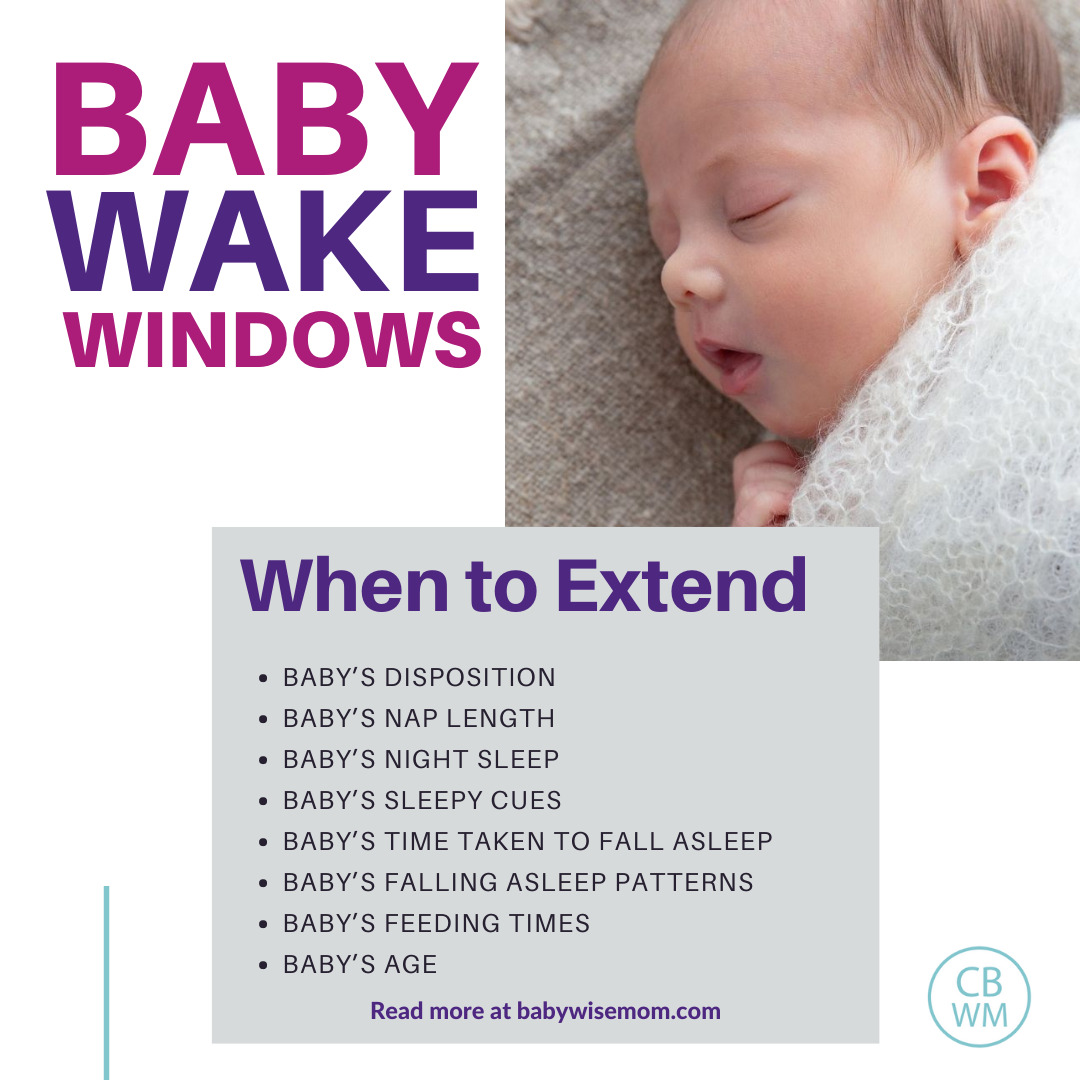
Baby’s Disposition
One big indicator is how long your baby can stay happy. Fussiness is a good cue that your baby is tired (or overly tired) and needs to go to sleep. If your baby can stay awake longer with a happy disposition, he might be ready for a longer wake time length.
As you consider this indicator, couple it with your baby’s typical disposition. If your baby is the type to go with the flow and rarely fuss, disposition will not help you out as much since baby will probably stay happy well beyond the perfect timing for a nap.
Conversely, a baby who tends to get fussy easily will be harder to read.
You also want to take note of baby’s disposition when he wakes up. If he is 4-6 months or older, he will start to wake up happy when nap time is over rather than wake up crying. If baby was waking up happy and is now waking up crying, waketime length might be off (baby also might be sick, teething, or in pain).
Baby’s Nap Length or Night Sleep
A huge indicator for you when determining wake time length is how well your baby sleeps. A baby who falls asleep easily without fussing and sleeps for 1.5-2.5 hours for a nap has good wake time length.
A baby who wakes after only 45 minutes or who wakes often in the night probably has wake time length off.
Keep in mind that there are many reasons for sleep being disrupted. Wake time length needing to shift is just one item on a very long list. So consider wake time length, but do not hone in on it.
Consider the other causes for poor sleep, also. Choose the one you think it most likely is and address it. If that fixes it, great! If not, return to common reasons for poor sleep and choose the next thing you think it could be.
Read these posts to help you out:
- Sleep Disruptions You Will Face as a Babywise Mom
- The First 5 Things to Check When Your Baby is Taking Short Naps
Please note that your baby will need to be able to fall asleep independently for you to be able to rely on nap length or night sleep for waketime length cues.
Sleep transitions are common and will cause baby to wake up, and if your baby can’t fall asleep independently, it will make it so he wakes more fully. Read more on sleep transitions here.
There are many benefits to sleep training. One of the biggest is that baby will sleep better!
>>>Read: Tips for Finding Your Child’s Ideal Bedtime
Baby’s Sleep Cues
Another indicator of ideal wake window is your baby’s sleep cues, assuming she has them.
Not all little ones will show sleep cues, and some who do show “too late” cues rather than showing “time for sleep” cues. Common sleep cues include a yawn or an eye rub. Read up on all common sleep cues here.
If cues are shifting, there is a chance wake time length needs to shift.
Keep in mind that many babies move from sleep cues being accurate to no longer being reliable, so if you think sleep cues are telling you to shift and you shift, but things don’t change, consider the possibility sleep cues are no longer reliable.
Baby’s Time Falling Asleep
A baby who is able to self-sooth but cries or who takes more than 20 minutes to fall asleep might have wake time length off. You want to be aware of how long it takes baby to fall asleep so you know if something changes.
Some babies just naturally need a longer length of time to fall asleep. They need more time to wind down.
I always liked my babies to fall asleep within 5-10 minutes of being put down, but if that is now how your baby is, adjust your expectations. The Baby Whisperer says if baby falls asleep within 20 minutes of being put down, wake time length was correct.
>>>Read: What To Do When Baby Takes a Long Time to Fall Asleep
Baby’s Falling Asleep Patterns
If baby is playing before nap time or bedtime, it might be time to extend wake time length.
A good indicator of the child being ready to extend waketime is when she plays in her bed instead of going to sleep. This needs to be something consistent, though. It needs to be that you are putting baby down at a time that has always been the perfect length of time and baby is now playing instead of going right to sleep.
If you put baby down late and baby doesn’t go right to sleep, that just means wake time length was too long.
If I put Kaitlyn down late, she would often play for a while before falling asleep.
Also, it is important to remember that babies just sometimes have an off nap or even an off day. Do not take one nap or one day as a sure indicator that your baby’s schedule needs to change. Watch for common patterns.
But if you are putting baby down at the same time every day and she plays for 20 minutes or more every day, then you can bet she is most likely ready to stay up longer.
An exception to this is when there are new skills your baby is working on. If your baby is working on crawling and decides to practice during nap time, then the staying up instead of going to sleep is simply her desire to work on her new skill and nothing to do with her optimal wake time length.
Read up on How to Stop New Skills from Disrupting Sleep here.
Another exception is if baby simply needs more exercise or mental stimulation. Extending wake time length can help this, but you might have to extend it too far to fit in with your feeding times (see below).
Needing to add exercise and stimulation tends to start around 9-10 months and older. Read up on the Importance of Exercise and Stimulation here.
>>>Read: Optimal Waketime Lengths for age-appropriate wake windows
Baby’s Feeding Times
Something you need to be sure to take into consideration is the amount of time before the next feeding.
You want baby to go down for nap in time to get the appropriate nap length before the next scheduled feeding.
If you are on a 3 hour schedule but your child can stay awake longer than one hour, just make sure they are getting 1-1.5 hours of sleep.
A newborn wake window is very short. Feeding time is included in wake window calculation, and even with that feeding time, it can be as short as 30 minutes for a newborn. See How Long Should a Newborn Be Awake Between Naps for help.
If your baby is 9 weeks or older, you want at least 1.5 hour naps. Once you move to a 3.5+ schedule, naps can be 2-2.5 hours in length.
If you are moving to a longer schedule (for example, from 3 to 4 hours), your baby might be able to stay up longer. Other babies move schedules and just take longer naps. It will depend on your baby’s need for sleep and the ability to stay awake successfully.
Baby’s Age
There are guidelines on how long to expect a baby to stay up. A young baby (2 months or younger) can pretty assuredly only do 45-60 minutes of waketime.
Remember, weeks 16-24 (about 4-6 months) are called Extended Day in Babywise. This is the time period many babies extend their waketime.
Get a graphic for wake time lengths by age in my post The Cornerstone for Good Naps
Another age consideration is the Wonder Weeks and normal times for sleep regressions. Sometimes sleep regressions happen. It doesn’t mean anything needs to change; it just means baby is getting older and developing. Read up on The Wonder Weeks and Sleep here.
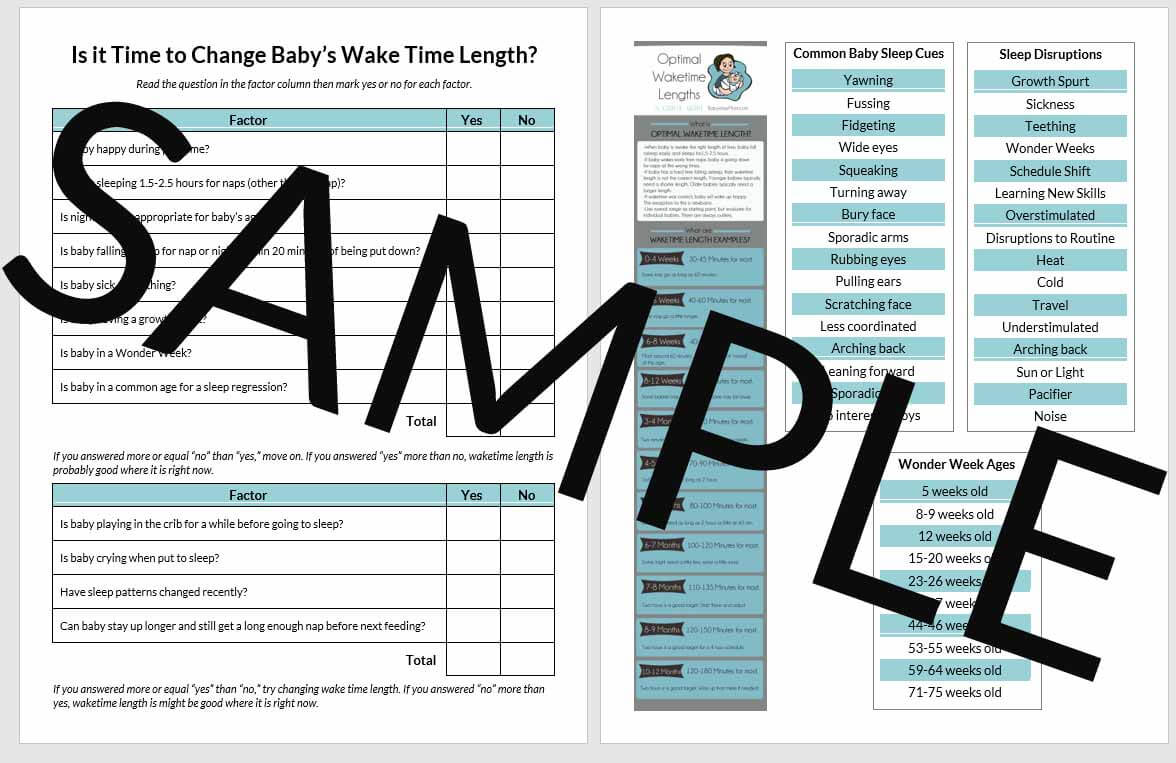
Be sure to check out my free Wake Time Length Worksheet to figure out if you should extend wake time or not.
Extending Wake Time Length
Now on to extending waketime. You now know some good aspects to your baby’s day to watch so you can know how to best pin down optimal wake time length. You have considered all of the possible reasons for the poor sleep and feel like wake time length is the thing that needs to change.
Now you want to know to extend wake time length.
Remember, don’t force your child to stay up. Wait until they are actually ready to extend.
Extending wake windows before baby is ready will only lead to poor sleep and a sleep deficit.
This is also true if you extend wake time length too far. If your baby only needed 5-10 more minutes of waketime length but you added on 30 minutes right away, you will build up a sleep deficit over time. Read more about a sleep deficit here (this is discussed in-depth in the book Healthy Sleep Habits, Happy Child).
Always keep in mind that sleep begets sleep. People often want to keep baby awake for as long as possible hoping baby will sleep better at night, but an overly tired baby does not sleep well consistently.
An overly tired baby crashes every once in a while and sleeps for a long time, but other times are just fussiness and/or lack of sleeping.
General Guidelines to Extend Wake Windows
How do you extend wake time length? Here are my general guidelines.
- Take note of baby’s current wake time length. No matter how good of a memory you have, you will want hard copy notes to look at. Write down what it is now so you know for sure where you started. I do have worksheets in my Chronicles of a Babywise Mom Book of Logs you can use to track wake time length effectively.
- Add time to what it already is. I recommend adding between 5-15 minutes at a time. Waketime length windows can be super sensitive, so if you add too much at once, it is very likely you will skip the perfect time altogether.
- Keep notes of your changes. Write down the waketime length you used. Take note of how that new time of longer stretches impacted the indicators listed above.
- Give the new wake time length time. Your baby might respond immediately but might also need a few days to settle in. You need patience here. But go with your gut. If you just know this is all wrong, change it.
- Remember waketime length can change throughout the day. It is common to have the shortest wake window at the beginning of the day and the longest at the end. Some babies are the same wake window all day long.
This means your first nap will happen very soon after waking up in the morning. This is okay! The next wake window will probably be longer.
This is just one more factor you need to figure out for your individual baby. Really focus on getting that first waketime length correct and then adjust from there.
Related Waketime Length Posts
- Optimal Waketime Lengths
- The Babywise Mom Nap Guide
- Chronicles of a Babywise Mom Log eBook
- The Cornerstone for Good Naps
- What To Do When Baby Wakes Early But Isn’t Hungry
- What To Do When Your Child is Playing in the Crib Instead of Sleeping
- Tips to Know When it is Time to Extend Baby Awake Time
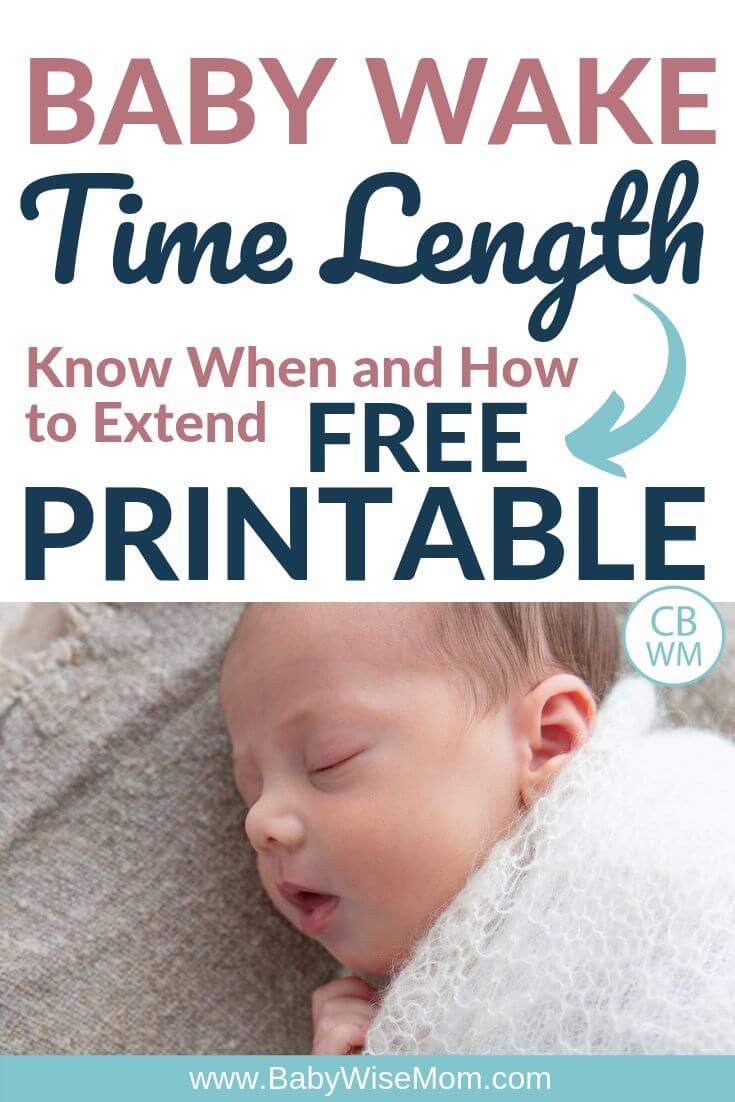
Reader Waketime Length Questions
- gormanhq said…
My second baby is 4 weeks old and we just started to really try to implement BW yesterday. Although I implemented many of the aspects of BW with my first (now age 3), this time around I thought I would just go with the flow (trusting my instincts–ha ha) and with the holidays, it was too hectic to try implementing the schedule from day one. Mostly all I did was focus on a full feeding and try to get some waketime in. But, our schedule was different each day and varied from 2-3 hours between feedings. Finally, I was fed up and got the book out for a refresher. Yesterday went fairly well as far as starting a schedule, and fortunately this baby goes to sleep on her own without much fussing. However, she has very sleepy times, where it is almost impossible to get her to have any “waketime”. I can usually get her to take a full feeding, but she sometimes just refuses to wake up after. So, she’ll sleep nearly the entire 3 hour cycle, but then she often wants to be up for the entirety of the next 3 hour period (maybe falling asleep only 20 minutes before the next feeding). Then, she’ll be exhausted and want to sleep the next cycle through, starting all over again. Any suggestions on how to break this? How much total waketime should a 4 week old baby be expected to have (ballpark?). Also, though she sleeps very soundly during her daytime naps, she is very restless at night (making it very difficult for me to get any quality sleep). Any suggestions for helping her sleep more soundly at night, or will this just come with time? (for the first 2 weeks she was a bit flip-flopped on her days/nights and seems to still be getting her best sleep during the day).Thanks!
Babywise Mom said…
I would say your average 4 week old can do about 45 minutes of waketime. Some may be able to do 1 hour. And not all waketimes are created equal. Some might be longer (evening perhaps) and others shorter (morning). You really do want to keep her awake for waketime so she will be more tired for naptime. I would suggest taking it one waketime at a time like I say in the post, but move faster than one a week. By four weeks you should be close to having waketime for each time period.Newborns do grow out of their extremely noisy sleeping, and mothers vary on how well they can sleep through it. I, myself, am not a sound sleeper, so the noisy baby simply prevents me from sleeping. I use earplugs and can still hear the baby when she cries, but not so much the groans and such. - sarah said…
Okay, we got the bedtime thing down. Thanks for your advice! We were right there, I just needed the right opinion of a BW mom to help me out! My baby boy (4 mths) has slept from 8-8 two nights in a row! He wakes up a few times during the night but falls back asleep in about 5 minutes so hopefully that will eventually disappear.Now onto naps which I never really thought about even after BW because I concentrated on the feedings so much (1st timer :)). He was napping 1.5 hours after feedings consistently but only sleeping for 45min.-1hour and would only do that twice a day. He was then eating every 2.5-3 hours because of the short naps. I started reading again about sleeping and realized his naps should be longer and he should have 3 naps that last 1.5-2.5 hours. The CIO worked a couple of times after he awoke 45 minutes in, but not consistently. So if I do the math correctly and drop back to 1 hr. 15 min. after feedings to see if he will take those longer naps, and try for a third one, does that mean that he will only be up about 6 hours each day? Is that right and normal? Just seeing if that is correct because I really want my little boy to be happy and well rested and right now, our evenings are NOT that at all! He begins to get really fussy around 6 p.m. and stays that way until we start his bedtime routine. Please share some more advice. Thank you so much. I really have learned a lot from your site.
Babywise Mom said…
Congrats on the nighttime sleep! That was a fast turnaround.The exact amount of sleep and waketime for each baby will vary based on individual needs, so you will have to see what is best for him. My first slept on the low end of average for babies, and my second sleeps on the high end. If your is a high end, that sounds about right. I would recommend seeing Easy Nap Fix and then looking at troubleshooting naps, which is linked off of the Easy Nap Fix. Those two posts can give you ideas for fixing nap problems. Good luck!
Troubleshooting naps isn’t referenced in Easy Nap Fix, it is the other way around Troubleshooting Naps

This post originally appeared on this blog in 2007


